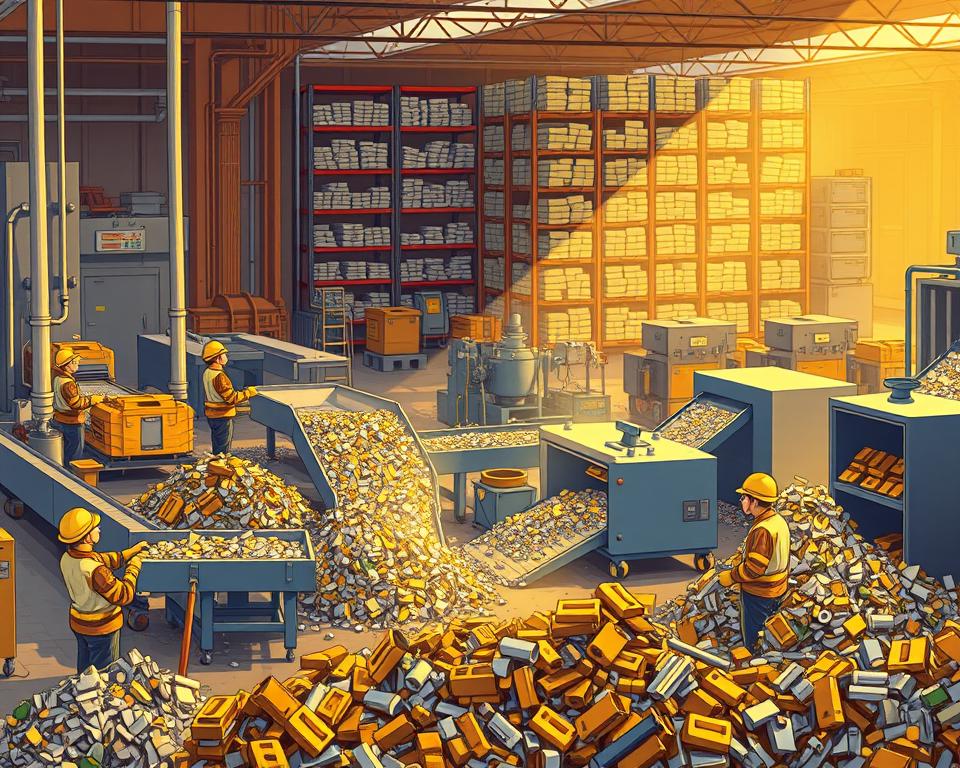Eco-Conscious Guide to Precious Metal Recycling
More than $60 billion in precious metals end up in e-waste every year—did you realize that? Such a massive amount highlights why precious metal recycling is so vital. Not only does it boost economic health, it also protects our environment. When we recover gold, silver, platinum, and palladium, we reduce pollution and conserve resources.
Companies like Dongsheng Metal Trading are leading the charge towards sustainability. They guarantee that valuable metals return to use instead of filling dumps. This precious metals recycling companies approach is key to eco-friendly recycling and sustainable practices.
Noteworthy Points
- More than $60 billion of precious metals end up in e-waste each year.
- Precious metal recycling reduces environmental impact and conserves resources.
- Gold, silver, platinum, and palladium top the list of valuable metals.
- Green recycling methods are essential for a sustainable future.
- Firms such as Dongsheng Metal Trading focus on precious metal recovery.
Understanding Precious Metals and Their Value
Naturally scarce metallic elements called precious metals draw interest from industries and investors. Gold, silver, platinum, and palladium are prime examples, known for their unique properties. They offer conductivity, resist corrosion, and occur in limited supply. The extraction and processing of these metals require considerable resources, underscoring the importance of recycling precious metals.

The value of precious metals is influenced by market demand and the inherent qualities of each metal. Recycling precious metals plays a critical role in sustaining the supply chain. It cuts the environmental toll of mining operations. Through exhaustive recycling processes, these metals can be restored to their original state. This preserves finite resources while yielding economic benefits.
Defining Precious Metals
Unique features make precious metals ideal for many uses. Economic value stems from their scarcity and innate qualities. Key examples include:
- Gold: Prized for its shine and tarnish-proof nature.
- Silver: Celebrated for its adaptability and conductivity.
- Platinum: Celebrated for its durability and catalytic properties.
- Pd: Gaining traction in cars and electronics.
Benefits of Precious Metal Recycling
Recovering precious metals plays a crucial role in sustainability. It preserves resources and lessens the environmental cost of mining. Consider these advantages:
- Reduction of environmental degradation caused by mining operations.
- Lower energy consumption compared to extracting new metals from the earth.
- Contribution to a circular economy by reintroducing materials into production cycles.
- Economic upside from extracting high-value resources.
Impact of Recycling Precious Metals
Recovering metals delivers big eco and financial wins. Emphasizing benefits helps cut environmental harm. Plus, it spurs economic development and steadiness.
Environmental Benefits
The environmental benefits of recycling precious metals are significant. When we recover metals from e-waste and scrap, landfill volume drops. It curbs mining demand and preserves nature.
It curtails mining’s damage, like habitat loss and toxins. A focus on metal recovery moves us toward real sustainability.
Economic Advantages
Financial perks of recycling are just as strong. Using reclaimed metals trims manufacturing budgets. It lets businesses choose reclaimed over freshly mined metals.
This shift creates jobs in recycling facilities and boosts market stability as demand for recycled metals grows. Using these financial benefits, companies can improve profits. They also contribute to a greener economy.
Steps in Metal Recycling
Recovering precious metals involves multiple steps for peak efficiency. Collection of e-waste, jewelry, and industrial scrap kicks off the process. They are sorted, decontaminated, and analyzed to gauge composition and value.
Recycling Workflow
A structured workflow is key to high-yield recovery. Every phase aims to maximize precious-metal returns. Sorting separates metals by type and purity. Cleaning removes contaminants that could hinder recovery. Analysis identifies the concentration of precious metals, guiding the choice of recycling techniques.
Recycling Techniques Used
Cutting-edge processes boost precious-metal recovery. One method, thermal reduction, leverages heat to separate metals from base materials. Melting refines and aggregates metals, while wet chemical processes are used for delicate separations. Recyclers like Dongsheng Metal Trading employ these approaches to improve yields and returns.
Types of Precious Metals that can be Recycled
Recycling is vital for the environment and for recovering valuable materials. Many precious metals can be recycled, benefiting both the economy and the planet. Knowing which metals are recyclable helps individuals and firms.
Key Precious Metals
Gold, silver, and platinum stand out among precious metals. You’ll see them in rings, currency, and industrial parts. Gold’s high price and use make it a prime recycling target. Silver recycling is also key, used in photography, electronics, and solar panels.
Platinum, though less common, is valuable, mainly in catalytic converters.
Rare Metals in Electronics
Electronics scrap contains metals ripe for recovery. Smartphones, laptops, and tablets contain rare metals like palladium and indium. Recovering such metals diminishes e-waste and yields vital materials.
It’s crucial to recover these electronic metals. Sectors strive to cut waste and boost recycling efficiency.
Who Gains from Metal Recycling?
Recycling precious metals supports industries by providing efficient, green resource supply. The electronics industry, with its frequent use of precious metals in devices, benefits greatly. Aerospace and medical sectors also depend on these metals for critical components. Exploring how these industries recycle precious metals reveals the environmental and economic benefits.
E-Waste Sector
Electronics spearheads recovery, given the metal content in phones and PCs. Quick device turnover spawns more electronic scrap. Thus, recycling gold, silver, and palladium efficiently becomes vital. That saves resources and cuts mining carbon footprints.
Businesses enhance recovery to align with green and zero-waste aims. That change bolsters resource saving and ecosafety.
Aerospace & Medical
Recycling precious metals matters for aerospace and healthcare, given their reliance on them. Durable, corrosion-resistant alloys are used in aircraft and medical tools. Metal recovery slashes expenses and ensures eco-compliance.
Both industries understand that responsible recycling practices help mitigate resource scarcity. And it improves operations, making metal recycling a smart green tactic.
Finding Precious Metal Recycling Companies
Locating reliable recycling partners ensures great results. You should probe their procedures thoroughly. Pricing models and processes make a big difference. Reviewing offerings lets you select wisely.
What to Ask a Recycler
- What certifications do you hold regarding precious metal recovery?
- What techniques do you use for each metal type?
- Which recovery percentages do you achieve for each metal?
- How do you handle pricing, and what additional fees might apply?
- Can you provide references or testimonials from previous clients?
Evaluating Offers
You must evaluate services side-by-side to pick the right recycler. Use a table to line up these factors:
| Company Name | Recovery Rate (%) | Processing Fee ($) | Turnaround Time (Days) |
|---|---|---|---|
| Recycling Co. A | 95 | 50 | 7 |
| Recycling Co. B | 90 | 45 | 5 |
| Recycling Co. C | 92 | 55 | 10 |
Side-by-side comparisons help pinpoint the ideal recycler. This ensures you get the most value and meet industry standards.
Precious Metal Recycling: Your Eco-Friendly Guide
Understanding how recyclers operate is key for those interested in precious metal recycling. They oversee everything from scrap pickup to refining. Such management secures peak resource use and profit.
Recycler Operations
Advanced workflows—assay, separation, smelting—unlock metal value. First, they gather scrap from multiple origins. Then, they use sophisticated techniques to separate different metals. In the last stage, precious metals are refined to purity.
This process not only maximizes resource recovery but also supports eco-friendly practices. It’s essential for long-term sustainability.
Choosing the Right Recycler for Your Needs
You’ll want to weigh several factors in your choice. Start with their sustainability track record. Now more than ever, green commitment is crucial. Next, review their service range—from pickup to refining.
Cost is equally important. Request estimates from multiple firms. Experts like Dongsheng Metal Trading provide industry-specific offerings. They stand out as dependable recyclers.
Pick the Right Facility
Recovery facilities are central to green waste solutions. Multiple types of facilities handle various recycling demands. Knowing the facility landscape helps you connect with the right partner. It aids companies and conserves nature.
Types of Facilities Available
There’s a broad spectrum of recycling operations. Some focus on precious metals, while others handle a wide range of materials. Common examples include:
- Metal Scrap Yards: Typically focus on general metal waste, including ferrous and non-ferrous metals.
- Precious Metal Recovery Companies: With a focus on high-value materials such as gold, silver, and platinum, these companies offer refined processing techniques.
- E-waste hubs target valuable metals inside tech devices.
Location and Access to Facilities
Accessibility to recyclers is key for efficient metal recovery. Firms need to plan transport logistics. Here are some factors that influence access:
| Factor | Description |
|---|---|
| Proximity | Facilities located nearer to businesses minimize transportation costs and time. |
| Partnerships | Having established relationships with local recyclers can enhance efficiency in recycling processes. |
| Service Range | Understanding the specific services of metal recycling facilities helps businesses select appropriate partners. |
Choosing appropriate centers and easy access drives recovery efficiency.
Recovering Metals from E-Waste
E-waste poses a major ecological challenge. Discarded devices often contain precious metals that can be recovered through recycling. That underscores viewing e-waste as a metal source.
Metals in Devices
Devices often contain bits of gold, silver, and palladium. These metals are found in various parts:
- Circuit boards
- Connectors and ports
- Capacitors and resistors
- Battery terminals
Common electronics conceal recoverable metals. By recycling, we retrieve and reuse these valuable elements.
E-Waste Recovery Benefits
Recycling electronics protects nature and recovers resources. It reduces landfill waste and saves natural resources. The benefits of recycling e-waste metals are clear:
- It minimizes environmental risks from improper disposal
- It reduces CO₂ output via green recycling methods
- It bolsters circular models by returning scrap to production
Promoting e-waste recovery advances resource stewardship. It secures a healthier planet for tomorrow’s children.
Future Trends in Metal Recovery
Metal recycling is evolving, spurred by tech advances and green initiatives. Facing resource limits, recyclers embrace new methods. By integrating novel processes, they pave the way forward.
Trends in Sustainable Recycling
Modern green recycling strives to cut waste and eco-damage. Firms now use bio-packaging and low-energy methods. These changes align with global sustainability objectives, pushing industries towards more responsible and planet-friendly behaviors.
Cutting-Edge Recovery Methods
Breakthroughs in recovery boost metal recycling yields. New technologies, such as automated sorting and hydrometallurgical extraction, enhance recovery rates. They boost recovery and cut environmental costs—a leap for metal recycling.
Launching a Metal Recycling Startup
Starting a precious metal recycling business demands meticulous planning and a deep grasp of operational and market dynamics. Leaders should map out steps, secure compliance, and set firm roots. Key tasks include market studies and pinpointing customer segments. Securing licenses and legal compliance is crucial for long-term viability.
Launching Steps
To launch your recycling venture, follow these steps:
- Conduct market research to understand needs and rivals.
- Develop a detailed business plan outlining goals and strategies.
- Acquire suitable recycling equipment that meets your operational needs.
- Raise startup funds through financing or investors.
- Obtain vital permits and licenses for legal operation.
- Launch marketing to attract clientele.
Compliance and Certifications
Understanding legal aspects when starting a precious metal recycling business is critical. Meeting environmental rules protects your operation and the planet. Key considerations include:
- Securing business certification from relevant authorities.
- Ensuring full compliance with disposal and recycling laws.
- Ensuring all employees are trained on safety protocols and procedures.
Bringing It All Together
Recovering precious metals conserves resources and protects our planet. It helps people and companies cut waste’s ecological toll. That reclaimed metal cuts mining demand and spawns recycling jobs.
Recycling goes beyond environmental benefits, also providing economic advantages. Partnering with companies like Dongsheng Metal Trading ensures a commitment to eco-friendly practices. This collaboration strengthens the circular economy, benefiting both recyclers and consumers.
Our path to sustainability relies on united metal recovery initiatives. Growing awareness can lead to a society that values responsible consumption and environmental care. Adopting these practices will benefit us now and secure a greener future for generations to come.


